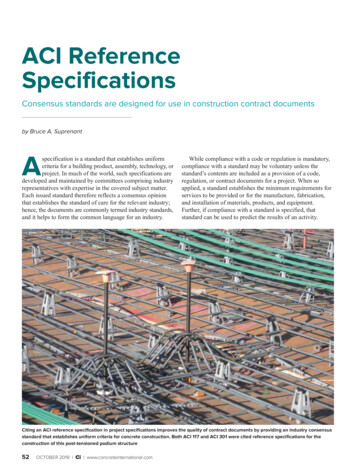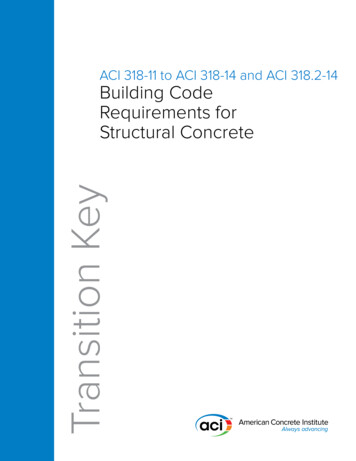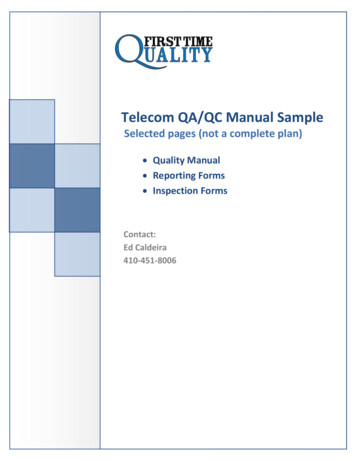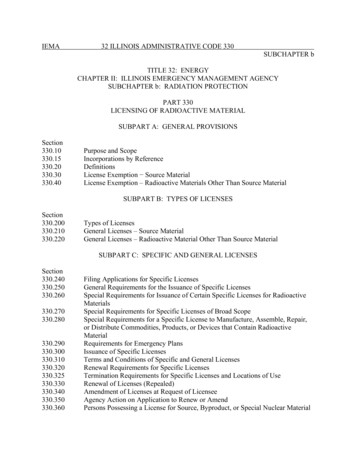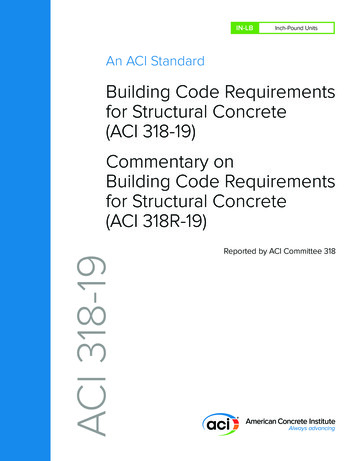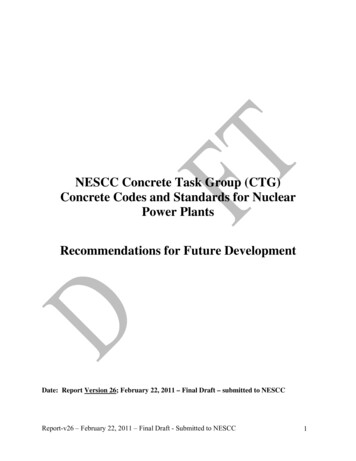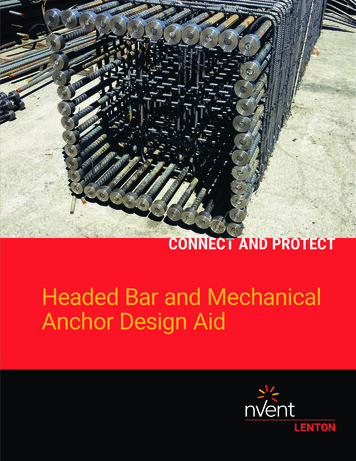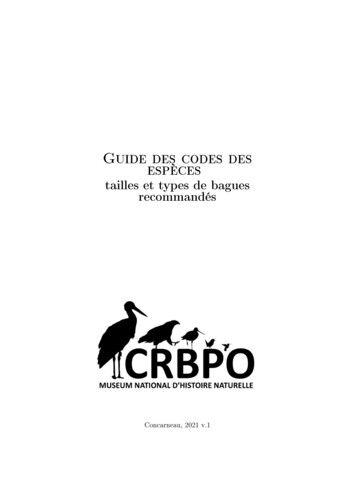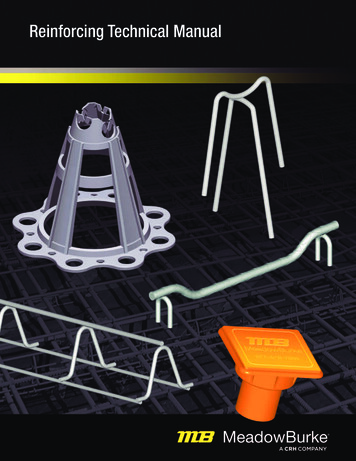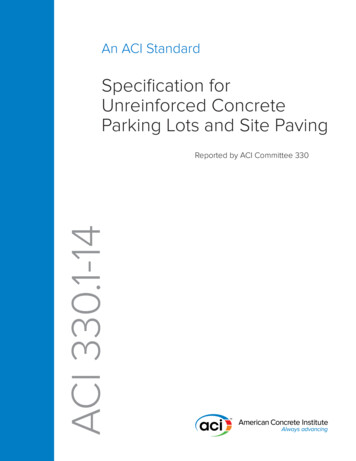
Transcription
An ACI StandardSpecification forUnreinforced ConcreteParking Lots and Site PavingACI 330.1-14Reported by ACI Committee 330
First PrintingNovember 2014ISBN: 978-0-87031-959-4Specification for Unreinforced Concrete Parking Lots and Site PavingCopyright by the American Concrete Institute, Farmington Hills, MI. All rights reserved. This materialmay not be reproduced or copied, in whole or part, in any printed, mechanical, electronic, film, or otherdistribution and storage media, without the written consent of ACI.The technical committees responsible for ACI committee reports and standards strive to avoidambiguities, omissions, and errors in these documents. In spite of these efforts, the users of ACIdocuments occasionally find information or requirements that may be subject to more than oneinterpretation or may be incomplete or incorrect. Users who have suggestions for the improvement ofACI documents are requested to contact ACI via the errata website at px. Proper use of this document includes periodically checking for errata for the mostup-to-date revisions.ACI committee documents are intended for the use of individuals who are competent to evaluate thesignificance and limitations of its content and recommendations and who will accept responsibility forthe application of the material it contains. Individuals who use this publication in any way assume allrisk and accept total responsibility for the application and use of this information.All information in this publication is provided “as is” without warranty of any kind, either express orimplied, including but not limited to, the implied warranties of merchantability, fitness for a particularpurpose or non-infringement.ACI and its members disclaim liability for damages of any kind, including any special, indirect, incidental,or consequential damages, including without limitation, lost revenues or lost profits, which may resultfrom the use of this publication.It is the responsibility of the user of this document to establish health and safety practices appropriateto the specific circumstances involved with its use. ACI does not make any representations with regardto health and safety issues and the use of this document. The user must determine the applicability ofall regulatory limitations before applying the document and must comply with all applicable laws andregulations, including but not limited to, United States Occupational Safety and Health Administration(OSHA) health and safety standards.Participation by governmental representatives in the work of the American Concrete Institute and inthe development of Institute standards does not constitute governmental endorsement of ACI or thestandards that it develops.Order information: ACI documents are available in print, by download, on CD-ROM, through electronicsubscription, or reprint and may be obtained by contacting ACI.Most ACI standards and committee reports are gathered together in the annually revised ACI Manual ofConcrete Practice (MCP).American Concrete Institute38800 Country Club DriveFarmington Hills, MI 48331Phone: 1.248.848.3700Fax: 1.248.848.3701www.concrete.org
ACI 330.1-14Specification for Unreinforced Concrete Parking Lotsand Site PavingAn ACI StandardReported by ACI Committee 330Robert Louis Varner, ChairDavid J. AkersRichard O. AlbrightJ. Howard AllredWilliam L. ArentJoseph P. BergmaierBryan M. BirdwellDavid W. BuzzelliMichael W. CookTim CostMichael S. DavyNorbert J. DelatteDouglas W. DenoEdwin H. GebauerNader GhafooriBruce A. GlaspeyOmer HeracklisJerry A. HollandJim HoolehanKenneth G. KazanisFrank A. KozeliskiFrank LennoxJohn R. Love IIIRichard E. MillerJon I. MullarkyMatthew A. OffenbergScott M. PalottaNigel K. ParkesJan R. PrusinskiDavid Newton RichardsonRobert Alan RoddenDavid M. SuchorskiScott M. TarrDiep T. TuChristopher R. TullDon J. WadeRichard L. WarrenConsulting MemberD. Gene Daniel3.4—Placing embedded reinforcement at joints, p. 43.5—Batching, mixing, and delivery, p. 43.6—Placing and finishing fixed-form pavement, p. 43.7—Placing and finishing slipform and laser-guidedscreed pavements, p. 53.8—Edging, p. 53.9—Final surface texture, p. 53.10 Tolerances, p. 53.11—Curing, p. 53.12—Hot- or cold-weather construction, p. 53.13—Jointing, p. 53.14—Opening to traffic, p. 6This specification covers minimum requirements for theconstruction of unreinforced concrete parking lots on grade.Included are requirements for submittals, testing and inspection,concrete materials, embedded reinforcement at joints, jointing andsealant material, forms, subgrade preparation, subbase, placing,texturing, curing, jointing, tolerances, and opening to traffic. Thisspecification does not cover requirements for pervious concrete.Keywords: construction; curing; inspection testing; jointing; pavements;site paving; texturing.CONTENTS(mandatory portion follows)PART 1—GENERAL, p. 21.1—Scope, p. 21.2—Definitions, p. 21.3––Referenced standards, p. 31.4—Submittals, p. 31.5—Storage and handling, p. 31.6—Testing and inspection, p. 3NOTES TO SPECIFIER, p. 6General notes, p. 6(nonmandatory portion follows)FOREWORD TO CHECKLISTS, p. 6MANDATORY REQUIREMENTS CHECKLIST, p. 7PART 2—PRODUCTS, p. 32.1—Concrete, p. 32.2—Embedded reinforcement at joints, p. 42.3—Membrane-forming curing compounds, p. 42.4—Joint and sealant material, p. 42.5—Forms, p. 4OPTIONAL REQUIREMENTS CHECKLIST, p. 8SUBMITTALS CHECKLIST, p. 8ACI 330.1-14 became effective July 22, 2014, and was adopted and publishedNovember 2014.Copyright 2014, American Concrete InstituteAll rights reserved including rights of reproduction and use in any form or by anymeans, including the making of copies by any photo process, or by electronic ormechanical device, printed, written, or oral, or recording for sound or visual reproduction or for use in any knowledge or retrieval system or device, unless permission inwriting is obtained from the copyright proprietors.PART 3—EXECUTION, p. 43.1—Subgrade preparation, p. 43.2—Subbase, p. 43.3—Setting forms, p. 41
2SPECIFICATION FOR UNREINFORCED CONCRETE PARKING LOTS AND SITE PAVING (ACI 330.1-14)(mandatory portion follows)PART 1—GENERAL1.1—Scope1.1.1 This specification covers requirements for theconstruction of unreinforced concrete parking lots and sitepaving on grade, including attached and integral curbs. Sitepaving includes entrance and exit lanes as well as drive laneswithin parking areas.1.1.2 Values in this specification are stated in inch-poundunits. A companion specification in SI units is also available.1.1.3 The Notes to Specifiers are not part of thisspecification.1.2—DefinitionsThe following definitions govern in this specification.For definitions not given below, refer to “ACI ConcreteTerminology (ACE CT)”, aspxaccepted—determined to be satisfactory by Architect/Engineer or Owner.Architect/Engineer—the architect, engineer, architecturalfirm, or engineering firm developing Contract Documents oradministering the Work under Contract Documents, or both.cold weather—a period when the average daily ambienttemperature is below 40 F (5 C) for more than threesuccessive days. Note: The average daily temperature isthe average of the highest and lowest temperature duringthe period from midnight to midnight. When temperaturesabove 50 F (10 C) occur during more than half of any24-hour duration, the period shall no longer be regarded ascold weather.construction joint—the surface where two successiveplacements of concrete meet, where the first placement hashardened before the next placement.Contract Documents—set of documents supplied byOwner to bidders during bidding phase of constructionproject. These documents include general requirements,contract forms, contract conditions, specifications, drawings,and addenda.contraction joint—formed, sawed, or tooled groove in aconcrete structure to create a weakened plane to regulate thelocation of cracking resulting from the dimensional changeof different parts of the structure. (Commonly referred to as“control joints.”)Contractor—the person, firm, or entity under contract forconstruction of the Work.dowels—smooth bars or plates, usually steel placed acrossa joint to transfer vertical load while allowing the joint toopen and close.free edge—the edge of pavement abutting an isolationjoint or the edge of the pavement against which no concreteis placed.hot weather—job-site conditions that accelerate the rateof moisture loss or rate of cement hydration of freshly mixedconcrete, including an ambient temperature of 27 C (80 F)or higher, and an evaporation rate that exceeds 1 kg/m2/h, oras revised by the Architect/Engineer.isolation joint—a separation between adjacent parts ofa structure that allows relative movement in two or moredirections. Isolation joints are usually vertical planes locatedto avoid formation of cracks in the structure.mild exposure condition—an environment in which theconcrete will not be exposed to freezing and thawing or todeicing agents.moderate exposure condition—an environment, normallyin temperate climate regions, in which concrete willonly occasionally be exposed to moisture and will not besaturated prior to freezing and where no deicing agents orother aggressive chemicals are used.Owner—the corporation, association, partnership,individual, public body, or authority with whom theContractor enters into an agreement and for whom the Workis constructed.panel—an individual concrete pavement slab bordered byjoints or slab edges.permitted—accepted by or acceptable to Architect/Engineer, usually pertaining to a request by Contractor, orwhen specified in Contract Documents.Project Drawings—graphic presentation of projectrequirements.Project Specification—written document that detailsrequirements for the Work in accordance with serviceparameters and other specific criteria.referenced standards—standardized documents of atechnical society, organization, or association, includingthe building codes of local or state authorities, which arereferenced in Contract Documents.severe exposure condition—an environment, normally incold climate regions, in which concrete may be saturated, orin almost continuous contact with moisture prior to freezing,and where deicing agents are used.site paving—paved areas intended for uses other thanvehicle parking or access drives; for example, pedestrianorwheeled traffic or storage of products, materials, or trailers.subbase—the layer in the pavement system between thesubgrade and the concrete pavement.subgrade—the soil prepared and compacted to support astructure or a pavement system.submit—provide to Architect/Engineer for review.submittal—document or material provided to Architect/Engineer for review and acceptance.supplementary cementitious material (SCM)—inorganic material such as fly ash, silica fume, metakaolin,or slag cement that reacts pozzolanically or hydraulically.testing agency—the person, firm, or entity under contractfor providing testing services.tie bar—a reinforcing bar, commonly a deformedreinforcing bar, intended to transmit tension through acontraction or construction joint.unreinforced concrete pavement—concrete pavementthat does not contain distributed deformed reinforcing barsor welded-wire reinforcement.American Concrete Institute – Copyrighted Material – www.concrete.org
SPECIFICATION FOR UNREINFORCED CONCRETE PARKING LOTS AND SITE PAVING (ACI 330.1-14) Work—the entire construction or separately identifiableparts thereof required to be furnished under ContractDocuments.1.3—Referenced standardsAmerican Concrete Institute117-10—Specification for Tolerances for ConcreteConstruction and Materials and Commentary301-10—Specifications for Structural Concrete305.1-06—Specification for Hot Weather Concreting306.1-90(02)—Standard Specification for Cold WeatherConcreting308.1-11—Specification for Curing Concrete311.6-09—Specification for Ready Mixed ConcreteTesting ServicesASTM InternationalA36/A36M-12—Standard Specification for CarbonStructural SteelA615/A615M-14—Standard Specification for Deformedand Plain Carbon-Steel Bars for Concrete ReinforcementC33/C33M-13—Standard Specification for ConcreteAggregatesC94/C94M-14a—Standard Specification for ReadyMixed ConcreteC150/C150M-12—Standard Specification for PortlandCementC173/C173M-14—Standard Test Method for Air Contentof Freshly Mixed Concrete by the Volumetric MethodC231/C231M-14—Standard Test Method for Air Contentof Freshly Mixed Concrete by the Pressure MethodC309-11—Standard Specification for Liquid MembraneForming Compounds for Curing ConcreteC595/C595M-14—Standard Specification for BlendedHydraulic CementsC618-12a—Standard Specification for Coal Fly Ash andRaw or Calcined Natural Pozzolan for Use in ConcreteC920-14a—Standard Specification for Elastomeric JointSealantsC989/C989M-13—Standard Specification for SlagCement for Use in Concrete and MortarsC1157/C1157M-11—Standard Performance Specificationfor Hydraulic CementC1567-13—Standard Test Method for Determiningthe Potential Alkali-Silica Reactivity of Combinations ofCementitious Materials and Aggregate (Accelerated MortarBar Method)D994/D994M-11—Standard Specification for PreformedExpansion Joint Filler for Concrete (Bituminous Type)D1751-04(2013)ε1—Standard Specification for PreformedExpansion Joint Filler for Concrete Paving and StructuralConstruction (Nonextruding and Resilient BituminousTypes)D1752-04a(2013)—Standard Specification for PreformedSponge Rubber Cork and Recycled PVC Expansion JointFillers for Concrete Paving and Structural Construction3D5893M-10—Standard Specification for Cold Applied,Single Component, Chemically Curing Silicone JointSealant for Portland Cement Concrete PavementsD6690-12—Standard Specification for Joint and CrackSealants, Hot Applied, for Concrete and Asphalt Pavements1.4—Submittals1.4.1 Submit drawings and documentation as required inthis specification.1.4.2 Obtain written acceptance of submittals from theArchitect/Engineer before using the materials or methodsrequiring acceptance.1.5—Storage and handling1.5.1 Store construction materials in a clean, dry location.1.6—Testing and inspection1.6.1 General1.6.1.1 Tests required to document submittals, certifyproduct compliance with this Specification before use inconstruction, establish concrete mixture proportions, provideacceptability of changes requested by the Contractor, orappeal rejection of material found defective by Owner’stesting agency shall be performed by accredited laboratoriesusing ACI-certified technicians.1.6.1.2 The Work in progress will be inspected, andmaterials, equipment, and procedures will be evaluated forquality and acceptability by representatives of the Owner oras designated in the Contract Documents.1.6.2 Contractor’s responsibilities––Contractor shallpermit and facilitate access of Owner’s testing agency tothe construction site for the performance of all activitiesfor quality assurance and quality control by theserepresentatives, including inspection and testing required inthese specifications.1.6.3 Responsibilities of Owner’s testing agency1.6.3.1 Concrete shall be tested in accordance with ACI311.6.1.6.3.2 Concrete test results shall be distributed to Owner,Architect/Engineer, Contractor, and concrete supplier.1.6.4 Acceptance of pavement—Failure to detect defectivework or material shall not prevent later rejection if defectsare discovered, nor shall it constitute final acceptance byArchitect/Engineer.PART 2—PRODUCTS2.1—Concrete2.1.1 General—Provide concrete meeting the requirementsof 4.2.2.7 of ACI 301 based on the exposure classes definedin the Contract Documents. Concrete shall comply withASTM C94 and the following requirements.2.1.2 Cementitious material—Cement shall comply withASTM C150, ASTM C595, or ASTM C1157. Supplementarycementitious materials (SCMs) are permitted to be usedto replace cement. Fly ash to meet requirements of ASTMC618 when used. Slag cement to meet requirements ofASTM C989 when used. The maximum replacement ratesAmerican Concrete Institute – Copyrighted Material – www.concrete.org
ACI 330.1-14 Specification for Unreinforced Concrete Parking Lots and Site Paving An ACI Standard Reported by ACI Committee 330 David J. Akers Richard O. Albright J. Howard Allred William L. Arent Joseph P. Bergmaier Bryan M. Birdwell David W. Buzzelli Michael W. Cook Tim Cost Michael S. Davy Norbert J. Delatte Douglas W. Deno Edwin H. Gebauer .
